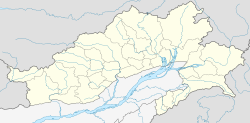Pasighat
| Pasighat | |
|---|---|
| City | |
| Location in Arunachal Pradesh, India | |
| Coordinates: 28°04′N 95°20′E / 28.07°N 95.33°ECoordinates: 28°04′N 95°20′E / 28.07°N 95.33°E | |
| Country |
|
| State | Arunachal Pradesh |
| District | East Siang |
| Area | |
| • Total | 14.60 km2 (5.64 sq mi) |
| Elevation | 153 m (502 ft) |
| Population (2011) | |
| • Total | 24,656 |
| • Density | 1,504.9/km2 (3,898/sq mi) |
| Time zone | IST (UTC+5:30) |
| PIN | 791102 |
| Telephone code | 0368 |
| ISO 3166 code | IN-AR |
| Vehicle registration | AR-09 |
| Climate | Cwa |
| Website | www |
Pasighat is the headquarters of East Siang district in the Indian state of Arunachal Pradesh. Situated at 155 meters above mean sea level, Pasighat is Arunachal's oldest town.
Pasighat was founded in 1911 A.D. by the British Raj as a gateway to administrative convenience of the greater Abor Hills and the north area in general. Primarily there were settlements of Adi tribesmen who are still living in the villages in and around Pasighat. Year 2011 (January) marked 100 years of its existence.
Cognizance of Pasighat emerged due to the last Anglo-Abor War that was fought in 1912 subsequent to fourth Anglo-Abor War in 1894. This necessitated the first ever administrative headquarters being established here with an Assistant Political Officer posted. In the post-independent Era, Pasighat is credited with the first Airfield (near Paglek, P.I. Line) established in 1946. The first Agricultural Institute in Arunachal Pradesh was also established at Pasighat in 1950. Other forms of later infrastructural development include:
Early proponents for shifting the state capital from Shillong (the then NEFA), underlined Pasighat's better infrastructure. However, the privilege was lost to the present capital Itanagar in 1974. The only significant development in Pasighat that came after that was the College Of Horticulture and Forestry Central Agriculture University established on 7 March 2001.
Pasighat is located at 28°04′N 95°20′E / 28.07°N 95.33°E. It has an average elevation of 153 metres (501 ft). The area experiences tropical humid climate during summer and dry mild winter. The area receives heavy rainfall every year during the monsoon season, starting from May until September. The unique trough like features surrounded by high hills on all three sides make this place ideal for attracting rain bearing cloud which come in from the Assam plain. The rain bearing wind gets obstructed by the hills and brings heavy downpour. Winter is marked by cold dry local seasonal wind which blows throughout the winter. This factor contributes in making this place fog-free even in winter. The Brahmaputra emerges from the foothills under the name of Dihang or Siang. It enters India as Dihang, west of Sadiya town in Arunachal Pradesh. Flowing south-west, it receives its main left bank tributaries, viz. Dibang and Lohit; thereafter, it is known as the Brahmaputra. Then it crosses the Pasighat area heading for the Assam plains.
...
Wikipedia


